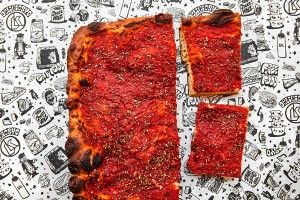Revisited And Reviewed: Chip Roman’s Blackfish Is Better than Ever
You’ve heard the story before: Young chef opens shoebox-size BYO. Cooks for a few dozen people every night. The critics fall in love. He keeps it humming for a spell, staying small—until suddenly he can’t resist any longer. Chefs may get all the love, but restaurateurs? They get the money.
So he opens another place. Why not? We’re talking about a guy who used to cook at Le Bec-Fin. People give Place Number Two the benefit of the doubt—at least to begin with. It makes the Philly Mag 50 top five. Squeaks into Esquire, too. Watch out, Jose Garces.
Flash-forward a couple years.
Place Number Two calls it quits. Nobody much laments it. We’ve still got the little BYO we first fell for. Until the shutters close on that, too.
By the time Place Number Three is born (as a clone of Place Two), and Place Four stirs serious befuddlement with crab scrapple, “pig wings,” burgers on doughnut rolls, and cooking blunders all over the place, it’s almost as though good old Place Number One never existed at all.
That’s not Chip Roman’s story—not yet, at least. But it is a cautionary tale. Roman, like Daniel Stern (of Gayle and Rae, now both closed, MidAtlantic which closes tonight and R2L which remains open), made his bones at Le Bec-Fin. He went out on his own with Blackfish, a small BYO that overcame its Conshohocken address to rise to the top of Philly Mag’s Best Restaurants list. And while he kept his restaurateur ambitions in check a bit longer than Stern did, last year he busted out of the BYO box by backing Mica, in Chestnut Hill, and Ela, in Queen Village (about a block from the old Gayle).
Mica didn’t quite do it for me—at least not all the way, as Blackfish had. Ela, my main review in this month’s issue of Philadelphia magazine, captivated me more—but even though Roman’s not in that kitchen, it is another distraction, and I wondered whether his expansion into Philadelphia had impaired his excellence at Blackfish.
There are some questions that only a five-course tasting menu can answer. (Other questions, like the time-honored “How did that no-account bastard get to be a restaurant critic?,” can only be answered with peals of maniacal laughter.) Then there are still more questions—and this turned out to be one of them—that can only be answered by a five-course tasting menu plus a couple extra courses. But that includes an amuse-bouche—a kusshi oyster on the half-shell, sprinkled with salmon-colored trout roe that popped between the teeth as only large caviar can. It left my companion wanting more kick, but to me it was a pure, saline evocation of the ocean, needing no other embellishment beyond the faint smell of the seaweed that cradled the shell.
The next dish blew us both out of the water. Here was embellishment in overdrive: striped bass crudo slicked with a concentrated yuzu syrup—a wallop of citrus both sweet and bracing—that gave way to the pin-and-needle tingle of pink peppercorns, moderated with a subtle, cleanly articulated balm of micro cilantro.
It couldn’t get better than that, only different. Roman has been wrapping cured salmon around fried eggs since Blackfish’s early days, and what this heavy hors d’oeuvre lacked in excitement (on the heels of that crudo, particularly), it made up for in mellow comfort. A runny yolk, a diaphanously thin potato chip, and a fair heap of cool-but-not-chilly salmon: It’s the sort of thing you can picture the last of the Romonovs eating, imprisoned with their cook at the Alexander Palace, before the Bolsheviks put an end to all that.
Next came truffled gnocchi with a mild chicken sauce—honest and bone-warming fare on a very cold evening, but destined to fade in the memory of the duck that followed.
Fanned out over a smear of parsnip puree, the rose-colored petals of meat were a phenomenally juicy reminder of why we eat duck breast to begin with. Not as a vehicle for cherry compote or red wine and plum sauce, or whatever sweet accompaniment often steals the show, but for the gamy succulence the lean meat retains when cooked by careful hands. The side of pureed mustard greens may have been pimped beyond recognition with sugar and sherry vinegar (not necessarily a cause for complaint), but the fowl achieved perfection on its own terms, slowing the pace of our meal to the most enjoyable crawl as each bite became smaller, needing only a swipe in its own luxuriant jus to lull us into a drawn-out rhythm between it and sips of a seriously good pinot noir.
Dessert came too quickly: a raspberry beignet that was fine, but rather slight given what had preceded it. As the pinot opened up further, I would have been game to start over and order another five courses, if only so I could sit a while longer in the spare white dining room. We had a cheese course instead, highlighted by a creamy Morbier whose layer of vegetable ash separated the morning milking from the evening one.
The first time I ate at Blackfish, in 2007, I sat next to the stack of cookbooks from Alice Waters and Charlie Trotter that were the splashiest decorations there. Those authors, it was clear, registered to me as Roman’s heroes. Four and a half years later, they seem more like his colleagues. Expanding into Philadelphia hasn’t impaired Roman at all. Dinner now is better than it was then. The restaurant—staffed by polished but understated servers who know when to appear and when to make themselves scarce, how to pace a meal and how to extend it when the mood is right—breathes with confidence and ease. Our five courses and their bookends spanned a wonderful range of tones, from the austere oyster and subtle fowl to the almost gaudy (but still tightly controlled) flourishes of the yuzu’d and pink-peppered bass crudo.
So long as Roman’s first place stayed this good while Places Two and Three got up and running, I’ll just go ahead and say it now: Come on, Chef. Bring on Place Four.
Blackfish [Official Site]
Photos by Ryan Lavine

